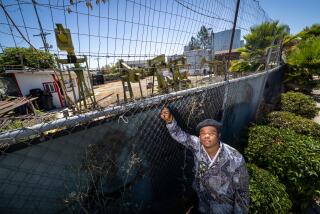Occupy movement turns 1 year old, its effect still hard to define
NEW YORK — They linked arms, sat and waited for arrest at Zuccotti Park. As police — well, activists playing the role — yanked them into custody one by one, they began chanting: “The whole world is watching!”
Occupy Wall Street’s dress rehearsal this week came ahead of demonstrations in Manhattan and around the country Monday, when organizers hope to again draw attention to economic woes facing “the 99%.”
On Monday, a year will have passed since activists took over the park near the symbolic heart of American capitalism, sparking a movement with offshoots in Los Angeles, Chicago and elsewhere around the world.
Interactive timeline: Occupy Wall Street
But the movement has yet to have a broad tangible effect, leaving some to wonder whether it will fizzle.
Polls have shown that the public generally supports Occupy’s message but not its disruptive tactics. A majority of respondents in one poll this spring said the movement had run its course.
As the Occupy movement turns 1 year old, its primary target — Wall Street — keeps churning out scandals. Major banks have been caught rigging key interest rates, laundering money and taking risky bets that lose billions of dollars.
Yet the movement cannot claim any new policy, law or regulation as its own. Unlike the Tea Party on the political right, there is no cohesive Occupy group promoting candidates in November’s national election.
“After the media effects wore off, a lot of politicians just figured out that these people weren’t going to matter,” said Theda Skocpol, a professor of government and sociology at Harvard who co-wrote a book about the Tea Party.
“Politicians pay attention to people who vote or who organize and spend money in elections,” Skocpol said. “That’s what Tea Party did and does, and that’s what Occupy doesn’t do. I don’t think it matters very much anymore.”
Occupy activists achieved scattered local victories involving a number of issues, including labor rights and foreclosures. Unions and housing advocates have joined forces under the decentralized movement’s umbrella cause against income inequality and the financial system’s unfairness.
“We changed the conversation,” said Amin Husain, a former corporate lawyer who was among Occupy Wall Street’s lead organizers last year. “We’re ringing that alarm bell with our bodies, with our voices, and we’re telling people, ‘Come out in the streets.’”
Although activists say they’re building a long-term movement whose goals and measures of success are evolving, the leaderless alliance of myriad activist groups and anarchists has struggled to organize.
In New York, the group’s general assembly halted meetings in the spring following internal disputes and disorganization. Activists here have been meeting in separate groups focused on more particular causes, such as the environment, labor rights, debt and discrimination.
Activists say their goal is to create a way to channel energy into affiliated groups seeking social or economic change, often locally and in ways that do not attract media attention.
“What we are doing radicalizes communities,” Husain said. “It makes them come out of the shadow to make the demands that they feel are just, that are necessary.”
Activists recently claimed victory in a labor dispute with workers at a restaurant in Manhattan’s wealthy Upper East Side. The Occupy Our Homes group takes credit for stopping dozens of foreclosures nationwide.
And on Wednesday, a group called Occupy Monsanto blocked access to the biotechnology giant’s Oxnard seed distribution center, where nine protesters were arrested for trespassing.
The movement takes partial credit for shaping the political climate that led New York Gov. Andrew Cuomo to reverse course and extend a so-called Millionaire’s Tax. Speeches by Elizabeth Warren, the U.S. Senate candidate from Massachusetts who has long been an antagonist of the financial industry, overlap with many of Occupy’s messages.
Some Occupy activists have pushed for particular policies, such as a financial transaction tax. But the movement’s core activists generally are wary of politics. Some identify as anarchists, but they are generally suspicious of politicians, worried about having their agenda constrained.
The Los Angeles branch of Occupy did have some early policy victories but has been largely silent since. Protesters helped usher in the passage of a “responsible banking” ordinance that requires banks doing business with the city to disclose detailed data about their lending practices in Los Angeles.
The ordinance first proposed by City Councilman Richard Alarcon more than two years ago had been languishing, but the arrival of protesters outside City Hall last October brought new momentum to the issue. The L.A. demonstrators made support for the ordinance an official part of their platform and spoke frequently at City Council meetings along with a broader coalition of community and faith-based groups to get the measure passed.
In turn, the City Council showed support for the protesters — passing a resolution in support of the protests and welcoming them when they camped outside City Hall. But lawmakers then turned their backs on Occupy. Mayor Antonio Villaraigosa ordered Occupy to decamp in late November, and some 1,400 police officers swarmed the area to clear protesters in a dramatic show of power that involved hundreds of arrests.
Occupy aims to create a “long-term movement of resistance” aimed at taking on injustice in the financial and political systems, said Mark Bray, a spokesman for the movement in the New York area. Occupy doesn’t want to confine itself to scoring policy victories.
“We have more of a fundamental critique of the political system and the economic system,” Bray said.
Todd Gitlin, a Columbia University sociologist who chronicled the movement in his recently released “Occupy Nation,” thinks the activists need to get political to remain relevant.
“If you’re trying to recruit people, you have to show them you can win something, and you can’t win anything without engaging the political system,” said Gitlin, who was a leader of the leftist group Students for a Democratic Society in the 1960s.
Occupy largely faded from public attention after cities nationwide removed activists’ encampments. But there have been some isolated incidents that thrust the Occupy protesters back into the spotlight. In New York, Occupy held a massive May Day rally that brought back their drums and banners to the streets. And in Los Angeles, the group made headlines in July at the monthly downtown Art Walk, where 17 people were arrested after police moved in on a group of protesters chalking the sidewalks.
Starting Saturday in New York, the movement plans three days of events. On Saturday organizers plan to release a “Debt Resistors’ Operations Manual,” described as “half survivor guide, half exposé of the lending industry.” Debt is among the themes of this year’s demonstration.
On Monday morning, organizers plan to form what they call “the people’s wall” around the New York Stock Exchange.
They’re encouraging activists to show up in business attire and form a sitting blockade around the exchange. Organizers then plan to block intersections before they “storm Wall Street,” starting at the federal Bankruptcy Court near the iconic bull statue.
What results from Occupy’s demonstrations may not be seen for years.
Frances Fox Piven, a political scientist and sociologist at the City University of New York, said the movement could last a decade or more and may compel the government to act even if activists don’t directly take part in political organizing.
“It could be a big movement, but it won’t happen on Sept. 17,” she said. “It’s not going to happen right away. It’s going to unfold over time.”
Interactive timeline: Occupy Wall Street
Times staff writer Kate Linthicum in Los Angeles contributed to this report.
More to Read
Inside the business of entertainment
The Wide Shot brings you news, analysis and insights on everything from streaming wars to production — and what it all means for the future.
You may occasionally receive promotional content from the Los Angeles Times.









